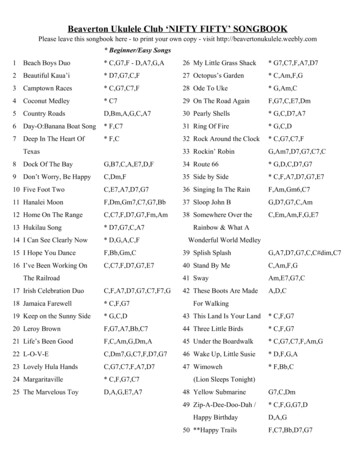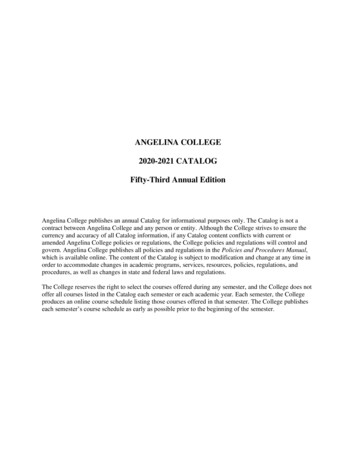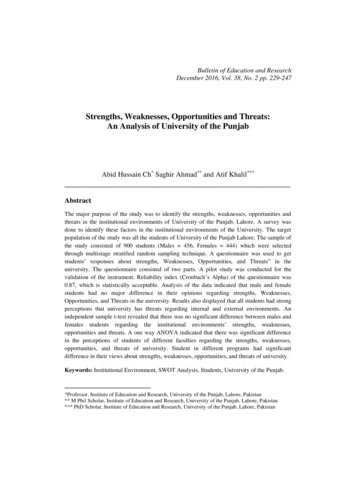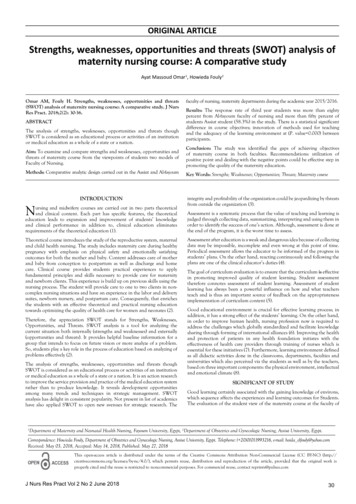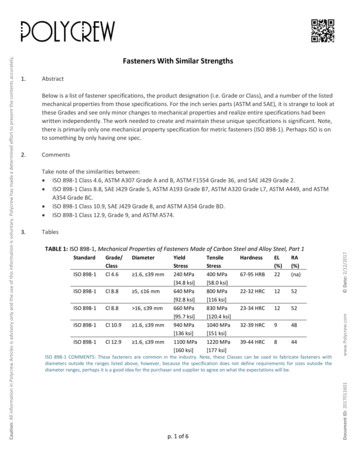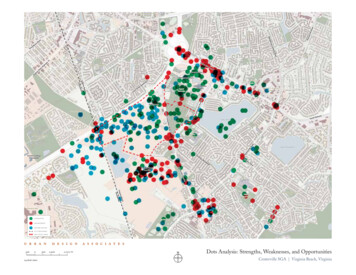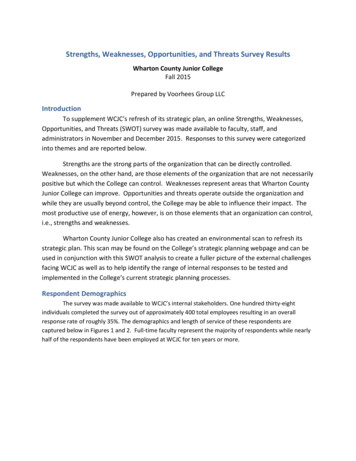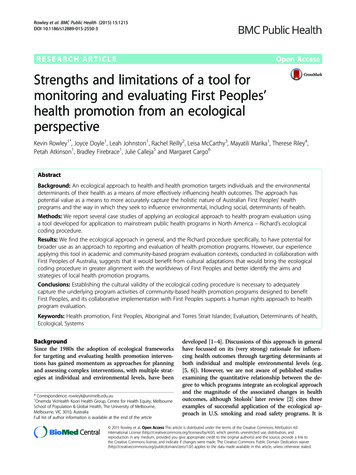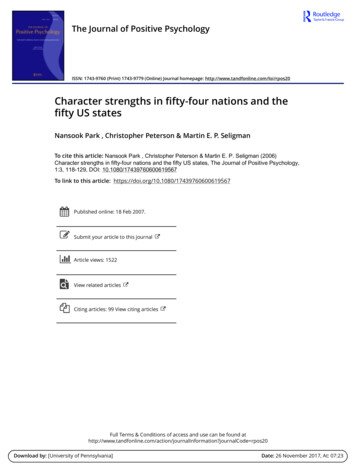
Transcription
The Journal of Positive PsychologyISSN: 1743-9760 (Print) 1743-9779 (Online) Journal homepage: http://www.tandfonline.com/loi/rpos20Character strengths in fifty-four nations and thefifty US statesNansook Park , Christopher Peterson & Martin E. P. SeligmanTo cite this article: Nansook Park , Christopher Peterson & Martin E. P. Seligman (2006)Character strengths in fifty-four nations and the fifty US states, The Journal of Positive Psychology,1:3, 118-129, DOI: 10.1080/17439760600619567To link to this article: https://doi.org/10.1080/17439760600619567Published online: 18 Feb 2007.Submit your article to this journalArticle views: 1522View related articlesCiting articles: 99 View citing articlesFull Terms & Conditions of access and use can be found tion?journalCode rpos20Download by: [University of Pennsylvania]Date: 26 November 2017, At: 07:23
The Journal of Positive Psychology, July 2006; 1(3): 118–129Character strengths in fifty-four nations and the fifty US statesNANSOOK PARK1, CHRISTOPHER PETERSON2, & MARTIN E. P. SELIGMAN31University of Rhode Island, USA, 2University of Michigan, USA, and 3University of Pennsylvania, USADownloaded by [University of Pennsylvania] at 07:23 26 November 2017AbstractIn a web-based study of 117,676 adults from 54 nations and all 50 US states, we investigated the relative prevalence of24 different strengths of character. The most commonly-endorsed strengths in the USA were kindness, fairness, honesty,gratitude, and judgment, and the lesser strengths included prudence, modesty, and self-regulation. The profile of characterstrengths in the USA converged with profiles based on respondents from each of the other nations. Except for religiousness,comparisons within the US sample showed no differences as a function of state or geographical region. Our results mayreveal something about universal human nature and/or the character requirements minimally needed for a viable society.Keywords: Character strengths; human nature; cross-national comparisons; within-US comparisonsAfter all there is but one race—humanity.Moore (1900)IntroductionGood character is essential for individuals andsocieties to thrive. After detours through the narcissism of the 1970s, the materialism of the 1980s, andthe apathy of the 1990s, people in the USA todaybelieve that character indeed is important. However,according to national polls, the contemporary USAis facing a character crisis on many fronts, from theplayground to the classroom to sports to entertainment to politics (Public Agenda, 1999). The detailsof this crisis seem to depend on the observer.Political pundits speak about a cultural war beingwaged in the world today, referring to a clashbetween traditional (conservative and/or religious)and contemporary (liberal and/or secular) values.Within the USA, the cultural war is framed in termsof the competing beliefs of those who live in the red(Republican) versus blue (Democratic) states thatentered public awareness in the aftermath of the2000 US presidential election (e.g., Greenberg,2004; White, 2003). Within the larger world, thecultural war is variously depicted as involving USversus European sensibilities or Judeo-Christianversus Islamic value systems (e.g., Adams, 2003;Pells, 1997; Qureshi & Sells, 1993).Regardless of the battlefield, participants in thecultural war make judgments about their owncharacter and those of their opponents. One’s ownside in this conflict is of course good, and theopposing side is bad. But whatever the evaluation,the other side is regarded as morally different. Tojudge from best-selling books in the USA, forexample, conservatives see liberals as permissivehedonists who are intent on plunging the countryinto ‘‘evil’’ (Hannity, 2004), whereas liberals seeconservatives as narrow-minded bigots who are‘‘lying liars’’ (Franken, 2003). This name-calling isechoed across international divides as well. We hearUS leaders characterize the country’s opponents ascowards who hate freedom, whereas these same USleaders are branded by their opponents as satanicwarmongers.Another point of view holds that we are neitheras polarized nor as morally dissimilar as polemicssuggest (Fiorina, Abrams, & Pope, 2005). Instead, itis the leaders and pundits who have become increasingly extreme in their words and deeds. What aboutthe facts of the matter? Do geopolitical distinctions(i.e., red versus blue states, USA versus Europeversus other regions) cleave people at the level ofbasic character strengths, as many commentatorshave argued, or is there an essential set of virtuesshared by most people in most places?Psychology’s interest in strengths of character hasbeen rekindled by positive psychology, and we seegrowing research literatures devoted to a variety ofCorrespondence: Christopher Peterson, Department of Psychology, University of Michigan, 525 East University, AnnArbor, MI 48109 1109, USA. Tel: 7347646567. E-mail: chrispet@umich.eduISSN 1743-9760 print/ISSN 1743-9779 online/06/030118–12 ß 2006 Taylor & FrancisDOI: 10.1080/17439760600619567
Character strengths119Downloaded by [University of Pennsylvania] at 07:23 26 November 2017Table I. Classification of character strengths.1. Wisdom and knowledge: cognitive strengths that entail the acquisition and use of knowledge. creativity: thinking of novel and productive ways to do things. curiosity: taking an interest in all of ongoing experience. judgment: thinking things through and examining them from all sides. love of learning: mastering new skills, topics, and bodies of knowledge. perspective: being able to provide wise counsel to others2. Courage: emotional strengths that involve the exercise of will to accomplish goals in the face of opposition, external or internal. honesty: speaking the truth and presenting oneself in a genuine way. bravery: not shrinking from threat, challenge, difficulty, or pain. persistence: finishing what one starts. zest: approaching life with excitement and energy3. Humanity: interpersonal strengths that involve ‘‘tending and befriending’’ others. kindness: doing favors and good deeds for others. love: valuing close relations with others. social intelligence: being aware of the motives and feelings of self and others4. Justice: civic strengths that underlie healthy community life. fairness: treating all people the same according to notions of fairness and justice. leadership: organizing group activities and seeing that they happen. teamwork: working well as member of a group or team5. Temperance: strengths that protect against excess. forgiveness: forgiving those who have done wrong. modesty: letting one’s accomplishments speak for themselves. prudence: being careful about one’s choices; not saying or doing things that might later be regretted. self-regulation: regulating what one feels and does6. Transcendence: strengths that forge connections to the larger universe and provide meaning. appreciation of beauty and excellence: noticing and appreciating beauty, excellence, and/or skilled performance in all domains of life. gratitude: being aware of and thankful for the good things that happen. hope: expecting the best and working to achieve it. humor: liking to laugh and joke; bringing smiles to other people. religiousness: having coherent beliefs about the higher purpose and meaning of lifepositive traits (McCullough & Snyder, 2000).For the past several years, guided by the perspectiveof positive psychology, we have been involved ina project that attempts to identify ubiquitouslyacknowledged strengths of character and ways ofmeasuring them (Peterson & Seligman, 2004). Wehave become concerned with how each of thestrengths is ranked in different societies. Our projecthas several notable features.First, we approached good character as a family ofpositive traits, each of which exists in degrees. Ourclassification includes 24 different strengths ofchaacter classified under six core virtues and makespossible nuanced descriptions (Table I).Second, we arrived at this family of characterstrengths by identifying core virtues recognizedacross world cultures and throughout history.Strengths of character that are arguably culturebound were excluded, and conclusions of somegenerality can potentially be drawn.Third, we devised measures of character strengthsthat have demonstrable reliability and promisingvalidity (Park & Peterson, 2005, in press; Peterson,Park, & Seligman, 2005, 2006). These measures askindividuals to endorse character strengths as moreversus less descriptive of their own thoughts, feelings,and actions. All of the strengths are ubiquitouslyvalued, which means that comparisons acrossstrengths are not confounded by a global responseset of social desirability. We can score our measuresipsatively, which allow comparisons within theindividual among greater and lesser strengths. Wecan also score them absolutely, and we can thereforerank order them within a nation or state.The present paper describes what we have learnedabout character strengths and their geographicaldistribution. Which strengths were most prevalentin different regions of the USA and which were leastprevalent was determined. The profiles of characterstrengths in other nations was examined, thosephysically and/or culturally close to the USA aswell as those more distant.Our own examination of widely influentialreligious and philosophical traditions found thatcertaincorevirtueswerewidelyvalued(Dahlsgaard, Peterson, & Seligman, 2005). Withinthese traditions, there was near universal acceptanceof the virtues of wisdom, courage, humanity, justice,temperance, and transcendence. In focus groupswith the nonliterate Maasai (in Western Kenya) andInughuit (in Northern Greenland), Biswas-Diener(in press) confirmed that instances of these samecore virtues were recognized and esteemed. Anon-arbitrary, empirically-grounded classification of
Downloaded by [University of Pennsylvania] at 07:23 26 November 2017120N. Park et al.ubiquitously-recognized character strengths thusseems possible (Bennett, 1993; Comte-Sponville,2001; MacIntyre, 1984; Rozin, 2003).These studies establish that certain virtues andstrengths are widely recognized, but this is a differentissue than which of these character strengths arerelatively common or relatively rare in terms of arespondent’s self-description. One perspective positsa pervasive human nature, shown in a handful ofcommon values and virtues displayed by most peoplein most societies because these dispositions areneeded for a group to survive and thrive (Bok,1995; Schwartz, 1994). This perspective suggeststhat not only will a set of strengths be ubiquitouslyrecognized, but that their rank order of prevalencewithin a setting will be much the same from placeto place.Another perspective holds that different strengthscome to the fore in different places for idiosyncraticcultural and historical reasons. We speak of nationalcharacter (Inkeles & Levinson, 1969; Peabody 1985)and may believe for example that collectivist Asiancultures are comprised of individuals who n cultures are densely populated by leaders(whether or not anyone follows them). Within theUSA (and other nations), regional stereotypesconcerning strengths of character are also heldnearly and dearly by many of us. We speak approvingly of small town kindness as well as big citysophistication.It is obvious that people in different parts ofworld differ from one another on a host of specificvalues, attitudes, and behaviors. Anthropologists,political scientists, sociologists, economists, andcross-cultural psychologists have amply demonstrated such differences, although in many casesthere are strong disciplinary inclinations to stresswhat is culturally specific over what is common.Researchers in these traditions are no more likelythan the rest of us to highlight effect sizes, whichmeans that the magnitude of statistically significantdifferences in cultural specificity receives littleemphasis.In terms of regional similarities or differenceswithin the same nation, we know very little. Althoughthe possibility of regional variation in psychologicalcharacteristics is sometimes acknowledged, these arerarely the focus of explicit investigation1. The almostuniversal reliance by psychology researchers onsamples from single settings precludes regionalcomparisons within the same study. Meta-analysesmight allow samples from different parts of the USAto be compared and contrasted across studies, exceptfor the convention of identifying the source ofresearch participants only in vague terms: e.g., ‘‘alarge state university’’ or ‘‘an urban communitymental health center.’’ In their search for generalprinciples and basic processes, investigators seem toregard their samples not simply as convenient butultimately as interchangeable.The purpose of this study was to determine whichcomponents of character are most and least commonly endorsed and to see whether this pattern isdifferent or similar across geographical and culturalcontexts.MethodResearch participantsThe sample consisted of all adult respondents whocompleted the Values in Action Inventory ofStrengths (VIA-IS) on the Authentic Happinesswebsite (www.authentichappiness.com) betweenSeptember 2002 and December 2003. After completing the VIA-IS on-line, a respondent receivedimmediate feedback about his top five strengths, andwe believe that this feature may motivate participants. We presume that respondents come to thewebsite to learn more about positive psychology aswell as about themselves. The VIA-IS is presentedon this website only in English, which means thatrespondents needed to be English readers.For the relatively small number ( 1%) of respondents who completed the measure more than once,only the first set of scores was used. The resultingsample was 71% from the USA (N ¼ 83,576). Alsorepresented were 34,887 respondents from about 200other nations. Only respondents from the 54 nationswith at least 20 respondents were included in theanalyses reported here (N ¼ 117,676) (Table II).Among our US adult respondents, there weremore females than males (72% versus 28%). Thetypical age of US respondents was 40 years of age,ranging from 18 to 65 plus. The typical level ofeducational attainment for US respondents was a fewyears of college, ranging from less than high schoolto post-baccalaureate. Relative to the US populationas a whole, respondents were more educated, andmany had college degrees (26%). The non-USrespondents were also predominantly female(62%); on average, they were about 40 years of age,and most were college-educated (68%).MeasureIntended for use by English-reading adults, theVIA-IS is a self-report questionnaire that uses a5-point Likert-scale to measure the degree to whichrespondents agree that strength-relevant statementsdescribe themselves (from 1 ¼ ‘‘very much unlikeme’’ to 5 ¼ ‘‘very much like me’’). There are 10 itemsfor each of the 24 strengths of character in the VIA
121Character strengthsTable II. Strengths profiles.WeightedDownloaded by [University of Pennsylvania] at 07:23 26 November 2017NationN with weighted US profile with US ehumorcuriositybeautycreativityperspectivesocial -regulationNationN with weighted US profile with US ehumorcuriositybeautycreativityperspectivesocial )(3.15)(3.30)(continued )
122N. Park et al.Table II. Continued.WeightedDownloaded by [University of Pennsylvania] at 07:23 26 November 2017NationN with weighted US profile with US ehumorcuriositybeautycreativityperspectivesocial -regulationNationN with weighted US profile with US ehumorcuriositybeautycreativityperspectivesocial (3.72)(3.56)(3.59)(3.25)(3.48)(3.50)(3.45)(3.28)
123Character strengthsTable II. Continued.WeightedDownloaded by [University of Pennsylvania] at 07:23 26 November 2017NationN with weighted US profile with US ehumorcuriositybeautycreativityperspectivesocial -regulationNationN with weighted US profile with US ehumorcuriositybeautycreativityperspectivesocial d )
124N. Park et al.Table II. Continued.WeightedDownloaded by [University of Pennsylvania] at 07:23 26 November 2017NationN with weighted US profile with US ehumorcuriositybeautycreativityperspectivesocial -regulationNationN with weighted US profile with US ehumorcuriositybeautycreativityperspectivesocial 0.710. .33)(3.32)(2.92)(3.45)(3.38)(3.28)(3.21)Notes: Figures in parentheses are raw mean scores. Ranks shown in table do not reflect tie scores, although ties were used in calculating thereported coefficients. Country abbreviations are as follows: AE ¼ United Arab Emirates, AR ¼ Argentina, AT ¼ Austria, AU ¼ Australia,AZ ¼ Azerbaijan, BE ¼ Belgium, BH ¼ Bahrain, BR ¼ Brazil, BS ¼ Bahamas, CA ¼ Canada, CF ¼ Central African Republic,CH ¼ Switzerland, CL ¼ Chile, CH ¼ China, CV ¼ Cape Verde, CZ ¼ Czech Republic, DE ¼ Germany, DK ¼ Denmark, ES ¼ Spain,FI ¼ Finland, FR ¼ France, GR ¼ Greece, HK ¼ Hong Kong, HR ¼ Croatia, HU ¼ Hungary, IE ¼ Ireland, IL ¼ Israel, IN ¼ India,IS ¼ Iceland, IT ¼ Italy, JP ¼ Japan, KY ¼ Cayman Islands, MX ¼ Mexico, MY ¼ Malaysia, NG ¼ Nigeria, NI ¼ Nicaragua,NL ¼ Netherlands, NO ¼ Norway, NZ ¼ New Zealand, PH ¼ Philippines, PL ¼ Poland, PT ¼ Portugal, SE ¼ Sweden, SG ¼ Singapore,TR ¼ Turkey, TW ¼ Taiwan, UK ¼ United Kingdom, US ¼ United States, UY ¼ Uruguay, UZ ¼ Uzbekistan, VE ¼ Venezuela,VU ¼ Vanuatu, ZA ¼ South Africa, ZW ¼ Zimbabwe.
Character strengthsDownloaded by [University of Pennsylvania] at 07:23 26 November 2017Classification (total 240 items). Details concerningthe reliability and validity of the VIA-IS are presentedelsewhere (Peterson, Park, & Seligman, 2005;Peterson & Seligman, 2004). Briefly: (a) reliability,all scales have good reliabilities ( 0.70); (b)stability, test–retest correlations for all scales overa 4-month period are substantial and in almost allcases approach their internal consistencies(r s ffi 0.70); (c) validity, self-nomination of strengthscorrelate substantially with the matching scale scores(r s 0.5); and (d) validity, rat
The Journal of Positive Psychology, July 2006; 1(3): 118–129 Character strengths in fifty-four nations and the fifty US states NANSOOK PARK1, CHRISTOPHER PETERSON2, & MARTIN E. P. SELIGMAN3 1University of Rhode Island, USA, 2University of Mic
